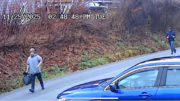Hunters are being asked to save the day regarding the future of white-tailed deer.
Again.
But this latest request comes with a Bizzaro World-type twist.
The Pennsylvania Game Commission rolled out its new chronic wasting disease response plan at a press conference in Harrisburg Thursday. It developed it in cooperation with scientists from wildlife agencies and conservation groups around the country.
The public can comment on the draft – preferably using the form at www.pgc.pa.gov through Feb. 29. Commission board members will take that feedback into consideration before adopting a final version next spring and implementing it next fall.
That won’t be a minute too soon, it seems.
Wasting disease, commonly called CWD, is an always-fatal ailment affecting whitetails and other cervids. Rogue proteins, called prions, cause it by forming holes in the brain.
There’s no live-animal test to check for it and no vaccine to cure it, said Courtney Colley, the commission’s CWD communications specialist.
“CWD is a silent killer. It sneaks into an area and picks off one individual at a time, slowly growing, right under your nose,” Colley said.
It’s insidious in its persistence.
Deer transmit the disease from one to another via direct contact or by shedding infected prions into the environment through feces, urine and saliva. Colley said they last in soil for years.
Not surprisingly then, the disease is spreading across Pennsylvania.
CWD was first discovered in a captive deer in 2012 and in three wild deer a few months later. Cases have nearly doubled annually since and now total 250. Ninety percent are in Bedford, Blair and Fulton counties.
That number will continue to grow, with the disease reaching ever new areas, unless something is done, said commission executive director Bryan Burhans.
“CWD is truly an ecological disaster unfolding before our eyes,” he said.
That’s where hunters come in.
The commission’s response plan calls for drawing a circle with a 3-mile radius around spots where CWD-positive deer show up.
If that circle falls within in an “established” area – somewhere the disease is in the soil and unlikely to be eradicated – the commission wants to kill enough deer to keep infection rates at or below 5 percent. If it’s in a “control” zone, or place that didn’t have disease previously, the goal is to kill enough deer to keep it from taking root.
In both circumstances, the commission will survey populations prior to hunting seasons, said Jared Oyster, its CWD coordinator. Those will determine how many deer need to die.
On average, that will be 350 per circle, Colley said. That’s about four more per square mile than are being harvested now.
Hunters will get first crack at taking them. And to help, the response plan proposes giving them three tools: additional antlered and antlerless licenses, concurrent buck and doe seasons and the removal of antler restrictions.
The commission will turn to sharpshooters operating over bait at night to take deer “if and only if” hunters don’t reach the target goal, Colley said.
Similar strategies worked elsewhere, she added.
Two states – New York and Minnesota – eliminated CWD in wild herds by quickly and aggressively using hunters and sharpshooters to lower populations where sick deer popped up. Colley said a third, Illinois, has maintained 2 percent prevalence rates since 2002 by consistently doing the same.
By comparison, wildlife officials in West Virginia are monitoring CWD but not intensively managing it, Colley said. And as a result, 35 percent of deer are infected in places.
So, with proper management, there is hope, Colley said. But hunter buy-in is critical.
It can be hard to come by.
The commission proposed using sharpshooters to kill deer in Bedford and Blair last fall, for example. Fierce public opposition stopped that.
But the time for such arguing is over, said Game Commissioner Charlie Fox. Pennsylvania can no longer hope to get rid of wasting disease, he said. It might yet manage it, though.
“Given the importance of our succeeding, and the consequences of our failure, it is imperative that we all work together on this critical issue,” he said.
Burhans agreed, saying it’s only with the support of hunters – “our front lines in dealing with this disease” – that scientists can hope to get a handle on CWD.
Hunters answered the call to save deer once before, noted Nick Pinizzotto, president and CEO of the National Deer Alliance, a sportsmen’s group focused on deer conservation.
A century ago, unregulated market hunting and habitat loss decimated white-tailed deer in Pennsylvania. The commission resorted to importing deer from elsewhere to rebuild herds.
Agency history says hunters fueled that turnaround.
But here’s the twist.
Back then, hunters helped deer by sacrificing opportunities afield. They accepted shorter seasons and smaller bag limits – pulling the trigger less often – and let deer live for the long-term good.
Now, the commission said, their job is to do the opposite. To save deer and deer hunting in the face of CWD they must sometimes kill more than they’re accustomed to.
It’s a big ask, Pinizzotto admitted.
Though discovered in Colorado in 1967, CWD only moved east of the Mississippi River this century. Many people don’t yet understand it, he said, so aggressive control tactics sometimes seem “far-fetched.”
“And that’s a challenge we face, getting sportsmen to embrace what we’re trying to do here,” Pinizzotto said.
Some, too, wonder about sacrificing when captive deer farms — Pennsylvania has more than 800 – could potentially move sick animals around the state.
The state Department of Agriculture requires all captive deer to be in one of two monitoring programs. It quarantines farms with CWD, said Kevin Brightbill, the state veterinarian.
That’s been 15 so far.
The program, in place since 2012, is similar in its aims to what the commission is proposing for wild deer now and seems to be working, Brightbill said.
Whether the department tweaks it remains to be seen. Agriculture spokeswoman Shannon Powers said feedback collected during this process will factor into any possible policy changes.
Then there’s the cost issue.
Though the commission manages all wildlife for all Pennsylvanians, it operates solely using hunter dollars. It gets no general tax revenue, for disease or anything else, Burhans said.
That’s always been the case, dating back to when hunters last alone funded the recovery of deer more than a century ago.
But, with the commission spending million annually on CWD – almost $2.6 million in 2018, with projections it will meet or exceed that this year — some question whether that’s sustainable now.
Harold Daub, executive director of the Pennsylvania Federation of Sportsmen and Conservationists, said “hunting as we know it” is in jeopardy.
But “hunters and the Pennsylvania Game Commission cannot fund this effort alone,” he added.
No matter what, hunters must tackle CWD starting now, Pinizzotto said. He called it “a very real threat to deer and our deer hunting traditions across the country.”
Previous generations did what was necessary to perpetuate their hunting heritage, he said. He’s hopeful this generation will follow in those conservation footsteps.
“Sportsmen came to the table and saved deer and other wildlife in the past,” Pinizzotto said. “We think we can do it again.”
What CWD looks like and how to handle it
Chronic wasting disease is deadly.
Hunting aside, deer with it are more likely to die, and die sooner, than healthy counterparts, said the Game Commission’s Courtney Colley. It can reduce populations on its own.
But you wouldn’t always know it to see sick deer.
Colley said it can take 18 to 24 months for deer to exhibit symptoms. So infected deer look healthy for a long time.
When symptoms do appear, they include droopy heads and ears, excessive drooling, thirst and urination, a rough coat, and behavioral problems, like losing their fear of humans and refusing to move.
The commission wants to know about any such deer people see.
“If you see something, please say something,” Colley said. “Report sick-looking deer to your local regional office.”
A list of those can be found here: www.pgc.pa.gov/InformationResources.
Meanwhile, there has never been a case of a human contracting CWD. However, in laboratory tests, it jumped the species barrier to infect non-human primates.
And it is related to mad cow disease, which can impact people.
So the Centers for Disease Control and Prevention recommends against consuming the meat from infected animals.
The commission will test hunter deer for free. Collection bins will be located in various places within its disease management areas. Hunters can deposit the head of their deer there and, within seven to 10 days, get a report on whether it’s safe to eat.
A map showing the location of those binds will be posted online soon here: pagame.maps.arcgis.com.
Bob Frye is the Everybody Adventures editor. Reach him at (412) 216-0193 or bfrye@535mediallc.com. See other stories, blogs, videos and more at EverybodyAdventures.com.































